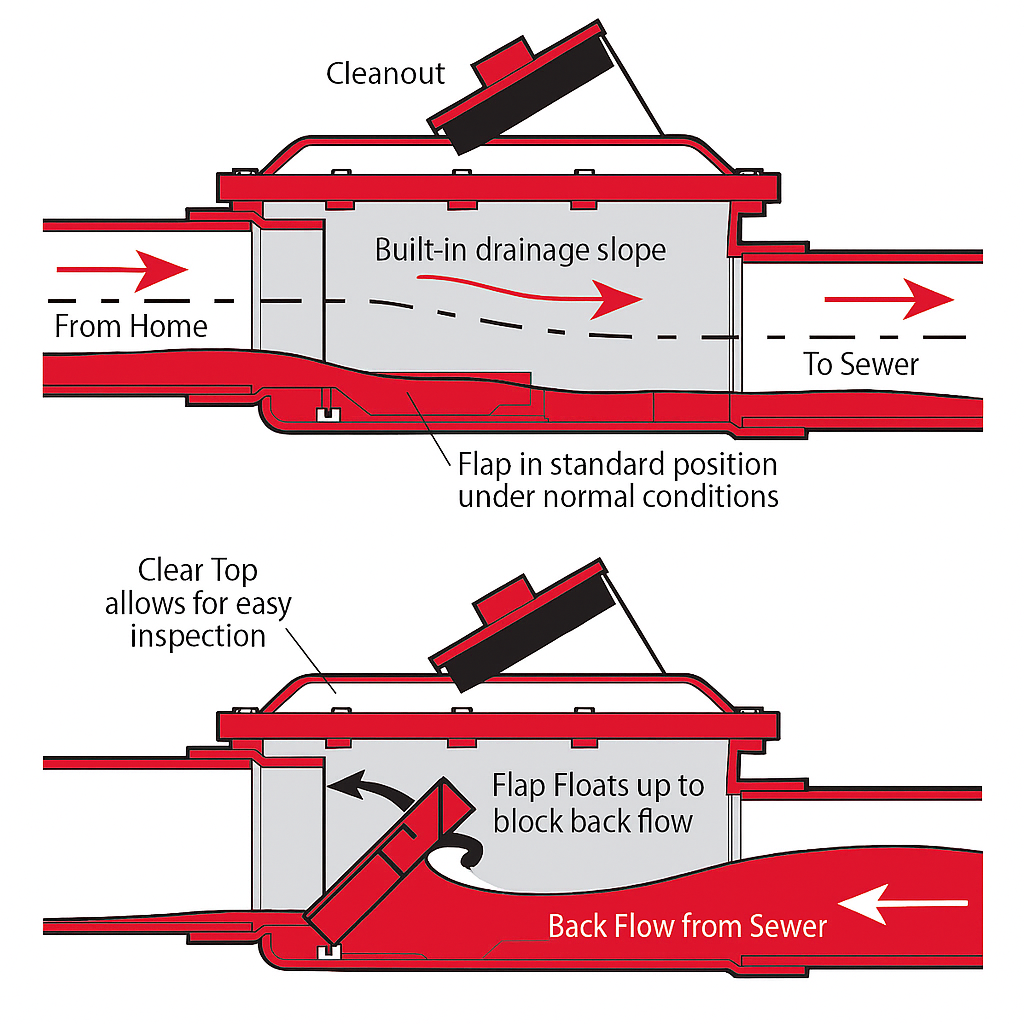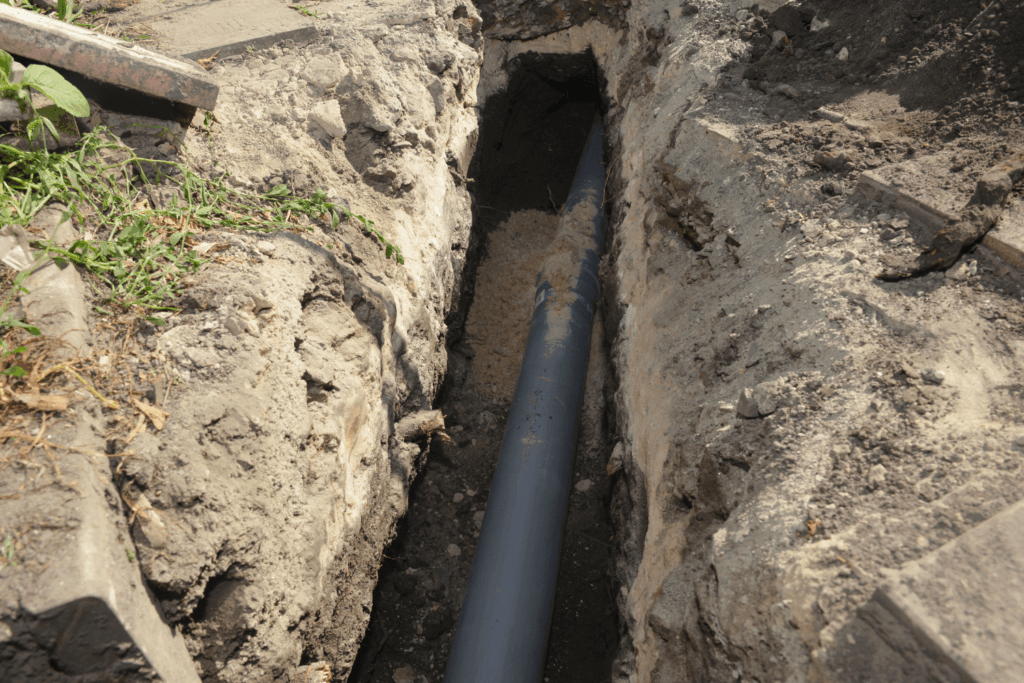A functioning backwater valve helps prevent sewer backup, protecting your basement, its contents, and your family. A backwater valve is what engages to block and reroute wastewater when it’s forced up your sewer line. Sewer wastewater that enters the home can cause damage to your home’s structure, the personal property it touches, and the health of your loved ones. Knowing the why and how behind installing a backwater valve is the first step to keeping it working properly to protect your property.
The Importance of a Functioning Sewer Line
The advent of basic sewers to collect and remove waste from homes and the cities they’re inside dates back thousands of years and is seen as one of the hallmarks of civilization. While technology has made the process more efficient, sanitary, and convenient, the basic purpose remains the same. Removing dangerous bodily waste is necessary for a clean, healthy home environment.
When sewers or the plumbing that feed into them break down, water and waste material can enter the home. This does more than just lead to a bad smell. It introduces air and waterborne bacteria. Pests are attracted by the smell of an easy meal in an environment less likely to draw humans and other large predators. The moisture, biological compounds, and chemicals in wastewater can begin to break down and damage organic building materials, and porous inorganic materials, like the cement used in foundations, can be permeated by the waste and bacteria.
Along with the airborne bacteria, decomposing waste releases gases that can cause headaches, nausea, and breathing problems. Mold that forms on damp organic material can begin to give off spores, further compounding the health risks of those in the home. Raw sewage cleanup can be dangerous and messy, which is why it requires extensive personal protective equipment.
In short, preventing a sewer backup is far better than dealing with the cleanup of the aftermath and the expense of sewer line repair, and that’s where backwater valves come in.

What is a Backwater Valve?
Backwater valves are installed in sewer lines between your home and the sewer main. As waste leaves the home, it flows freely through the valve, joins up with the flow in the sewer main coming from other homes, and proceeds to your local processing and treatment center. If water starts to flow back toward the home through that valve, however, it shuts to prevent a sewer backup.
How a Backwater Valve Works
As wastewater enters the backwater valve, it flows over and down a drainage slope inside the valve. This slope helps create a small amount of positive pressure that keeps the flow moving. When that pressure is counteracted by wastewater returning in the opposite direction, that same ramp begins to lift, creating a space underneath the ramp-like structure. As back pressure builds, the ramp becomes a seal forced against the roof of the backwater valve. The higher the backpressure, the more firmly the valve is held shut to prevent a sewer backup. As backpressure ebbs, the pressure of wastewater coming from the home reopens the valve, restoring normal flow.
What Can Trigger a Backwater Valve
While backpressure is what triggers the backwater valve, wastewater attempting to return up the sewer line can have several causes.
- Blocked Sewer Line – Sometimes the problem is a regular ol’ blockage in the sewer line, and one of the main culprits is improper material in the sewage line. Sewers are meant for waste and water. They have some capacity for other materials, like tampons and toilet paper, but their capacity for solids is limited. Sanitary napkins, “flushable” wipes (which often warn you in small print that they are not designed for flushing, and even an overabundance of toilet tissue can lead to clogs that block the flow away from your home.
- Sewer Main Backup – While the sewer main is much larger than your home’s sewer line, it can also be blocked, damaged, or otherwise compromised. While it may fall to your city’s sewer department to pay for the repair and maintenance, that’s not much consolation if it backs up into your home.
- Flooding – Flooding can compromise the sewer system’s ability to drain enough water to prevent backups. Without a backwater valve installed, your home’s basement may become the lowest point that rising floodwaters rushing through the city sewers can flow into.
- Root Infiltration – Tree roots can penetrate pipe joints or pierce the walls of some pipe materials. This is especially true in older neighborhoods where old clay sewer pipes remain in use. As the root grows and expands, thanks to the moisture and plentiful nutrients in your sewer line, it can block the flow and cause further damage.
- Broken or Collapsed Sewer Line – Over time, the weight of the coil, buildings, and even vehicles above sewer lines can cause them to crack, break, or outright collapse. This can leave raw sewage draining into the soil under your yard or block the line entirely, risking a sewer backup if you don’t have a backwater valve.
Backwater Valve Installation, Inspection, and Maintenance
For most homeowners, backwater valves are an unseen and unknown part of their home’s sewer system. Installing, inspecting, and maintaining them requires tools, skills, and experience beyond most DIYers. That’s why these jobs are usually best left to a professional.
- Installation – Installing a backwater valve involves excavating around the sewer line, cutting the existing line, and installing the valve in a gap created between the two pipe sections. In some cases, it may even require sewer line replacement to ensure you have a leak-free line you can count on to actively prevent sewer backup.
- Inspection – Your sewer pro is best positioned to spot signs of damage to your backwater valve. They know how to identify signs of damage from shifting soil, tree roots, or even wear from aging.
- Maintenance – If service is needed, your pro will do their best to find the least invasive approach to clearing the issue. If all else fails, however, excavation will be needed to replace your valve and ensure the surrounding pipes haven’t been compromised.
Your Excavation and Sewer Line Repair Specialists
We’re one of Pittsburgh’s most trusted excavation services, with crews servicing both private homeowners and larger general contractors throughout Western Pennsylvania. Our experienced sewer line repair and replacement team can identify the signs of broken sewer pipes, repair sewer line issues, and install backwater valves to prevent sewer backup under your home or inside your foundation. There’s no cost or obligation to get started.
When you schedule a free estimate, a sewer expert will inspect your property, discuss your concerns, and give you a written quote that outlines your home repair and protection options. We’ll be with you every step of the way, answering questions, repairing or upgrading your sewer line, and restoring your yard after the fact. The sooner you call, the sooner you have the peace of mind that you won’t end up with a smelly surprise in your basement and hefty repair bills.
Request your free estimate from A.M. Wall Anchor & Waterproofing today.

